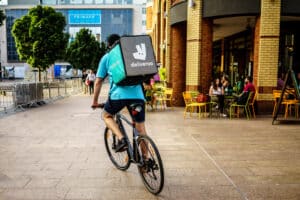
The soaring cost of living has taken a bite out of Deliveroo’s revenues as people cut back on takeaways to pay their household bills.
In an unscheduled second-quarter trading update today, the food delivery group sharply reduced its full-year revenue guidance.
However, its decision to maintain its underlying earnings guidance lifted its shares, which, after an initial 6 per cent slide driven by the revenue downgrade, recovered to rise 6¼p, or 7.3 per cent, to 91¼p — still far short of the 390p at which the company was floated in March last year.
The company’s gross transaction value, the total amount spent on orders, increased by 7 per cent to £3.56 billion in the first half, compared with a consensus market forecast of £3.62 billion, although the growth slowed from 12 per cent in the first quarter to 2 per cent in the second. In the UK and Ireland, the rate of growth in GTV fell from 12 per cent to 4 per cent, well below expectations of 18.4 per cent, and in the international business from 11 per cent to 1 per cent. Deliveroo now expects growth in full-year GTV to be in the range of 4 per cent to 12 per cent, compared with its previous guidance of 15 per cent to 25 per cent.
The company attributed part of the revenue downgrade to comparisons with last year’s lockdown, when basket sizes increased, but most of the problem appears to have been “increased consumer headwinds”. Indeed, Deliveroo blamed a more cautious economic outlook. Both the International Monetary Fund and the World Bank have cut their forecasts for global growth as a result of rising inflation and the war in Ukraine.
Consumer confidence has fallen in Britain as people face the biggest cost of living squeeze since the 1950s. Inflation has risen to 9.1 per cent and is forecast to rise to double digits in the autumn. In response the Bank of England has lifted interest rates to 1.25 per cent, which has increased concerns of a slowdown or possibly a recession.
Deliveroo said that despite the fall in spending per order it continued to expect an improvement in its adjusted profit margin for the year to between -1.5 per cent and -1.8 per cent of GTV. This compares with -2 per cent in 2021. The unchanged earnings forecast means that its full-year loss is now expected to be about £118 million, against £131 million suggested previously.
Deliveroo was founded in 2013 by Will Shu, 42, and Greg Orlowski, 43. It works with 190,000 riders and 170,000 restaurants in 11 countries and is moving into the rapid-delivery groceries market, working wth 13,000 sites. In March, it launched a non-food trial with WH Smith to deliver 600 products, including stationery and books.
Despite some concern over its persistent losses, it insisted that its balance sheet remained strong, and added that it was “confident in the company’s ability to adapt financially to a rapidly changing macroeconomic environment, through gross margin improvements, more efficient marketing expenditure and tight cost-control.”
Leading managed restaurants and pub groups in Britain, including Wagamama and Byron, enjoyed some of of the biggest increases in takeaway deliveries during the pandemic as people switched from going out to eat to eating in. Much of the growth was facilitated by Deliveroo, Just Eat and Uber Eats, However, latest figures from the Hospitality at Home monthly industry tracker, supplied by CGA by NielsenIQ and by Slerp, a software provider, show that since the hospitality sector has reopened such sales have levelled off, albeit remaining strong. For the five weeks to June 27, combined takeaway, click-and-collect and delivered sales through managed group operators were 113 per cent higher than they were over the same period in 2019, with delivery sales up 275 per cent over the three-year period.
Read more:
Demand for Deliveroo hit by rising cost of living





